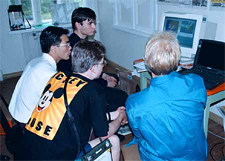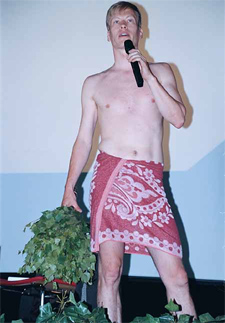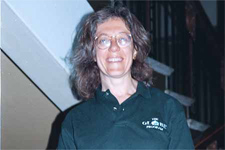July 3
Conference News: July 3
GLOBE research on Nuuksio:
No damage on nature despite closeness to Helsinki

After two days of games and studies in Nuuksio National Park, the results of research were analyzed and presented by GLOBE scientists. The data indicates that nature in Nuuksio is healthy despite park's closeness to Helsinki city area. Scientists, teachers and students made observations about atmosphere, soil, water, vegetation and weather. The results of the studies in Nuuksio are consistent with research conducted in similar areas.
Dr. Jack Fishman, GLOBE Atmosphere Principal Investigator will be developing ozone protocols for next year's GLOBE students. He and the students observed weather conditions by measuring soil temperature on an open site, wood site and a hill site in Nuuksio. They measured both maximum and minimum temperatures and also made measurements about wind direction and the amount of ozone. Lauri Laakso from Department of Physics, University of Helsinki showed GLOBE students satellite technology in order to view upcoming weather conditions.
Lake Saarilampi in top condition
"Even though Lake Saarilampi is brown, it is still safe to swim", states Dr. Martha Conklin, GLOBE Hydrology Principal Investigator. The reason for the brown colour is the decomposition of nearby forest leaves in the water. Dr. Conklin also explained the reason that there are trees growing in the lake. Recently, park officials closed off the canals between the lakes causing an increase in water level and flooding some of the trees.
Dr. Elissa Levine, GLOBE Soil Principal Investigator, discussed the soil site at Nuuksio National Park. Her studies showed that sand is the main soil type for that area. Forest vegetation studies show that in closed forest areas birch trees are most dominate. Dr. Barry Rock, GLOBE Land Cover Principal Investigator states that Nuuksio has the healthiest Norway Spruce he has ever seen. The oldest spruce seen was about 22 years old, the average life span only being between 15 and 20 years.
In closing, Dr. Dixon Butler, GLOBE Chief Scientist, exclaimed, "I am amazed at how much can be found with careful observation."
Conference authors: Kristin Marsh and Satu Kangas
Surviving the Sauna
All you need is common sense
When I opened the door to the sauna I was overwhelmed by the wave of heat that washed over me. This was my first time experiencing a sauna and I didn't quite know what to think. The heat (80-90 °C) was so intense that I was having a hard time breathing and seeing because I was not used to the warmth and humidity. I stood awkwardly, arms at my sides, next to a man I didn't know and looked around, observing my surroundings. There were about 25 people in the sauna and only a few were talking quietly to one another in a language I couldn't understand.
Soon some people left and I took a spot on the bench. I watched as someone poured the water over the rocks and felt the temperature rise. After a few minutes in the heat, I went to jump in the lake. At first I was numb to the cold but in a little while the water started to feel very refreshing. After swimming around in the cool lake I headed back to the sauna to repeat the process - over and over.
"Mister Sauna Man"

Running from a steamy warm room and jumping into a freezing cold lake does not seem like an appealing idea to most people. But to the Finnish, and as GLOBE participants were about to find out, it is a great way to relax. While in Nuuksio the students and teachers of GLOBE got the chance to experience a real Finnish sauna. Throughout the day people could be seen running between the sauna and the lake, making it one of the most popular activities of the GLOBE games.
"I have to get the right attitude," joked Dr. Kaarle Hämeri as he took off all his clothes except for a bathing suit he had on underneath at the start of his speech, "The culture and science in sauna" at Paasitorni on Friday. Dr. Hämeri went on to talk about the many uses the sauna has and the things people do in them: some people have been born in sauna, bodies of the dead have been washed in sauna, and it's been used to dry food. There are 3 million saunas in the world, and that 80% of them are in Finland. The eager students learned about air temperature, humidity, skin temperature, and how much a bather perspires in the sauna.
"Mister Sauna Man", as Dr. Hämeri called himself, talked about löyly, explaining that the steam in a sauna is not water droplets as many people believe it to be. Instead it is water vapor and it will not burn you like most people think it will. To justify his theory he challenged physicists to test it and told the rest of the audience to "just take my word for it.''
According to Dr. Hämeri the risks of sauna are easy to avoid with common sense, "I think you'd die if you stay a long time. So I'd say 15 minutes, 30 minutes, an hour, is the longest time to stay in there safely. There's no competition in sauna, you're just supposed to have a good time and if you're dying, you're not enjoying yourself."
Conference author: Marna Palmer
"Soils are amazing"
Dr. Elissa Levine has studied soil for over two decades

"When I was little my mother sat me in the soil and told me to play. I've been interested in it ever since," laughs soil scientist Dr. Elissa Levine when introducing herself to the attendees of the GLOBE conference. Levine, who has been studying soil for over two decades, has earned many degrees including her M.S and Ph.D in Agronomy from Penn State University, and her B.S. degree in Natural Resource Management from Kansas State University.
Dr. Levine works very closely with NASA. She is the lead scientist for NASA Global Change Master Directory. She also has designed soil protocol, developed learning materials and trained worldwide for GLOBE. In 1994 Levine was appointed Principal Investigation for the Soil Characterization Investigation of GLOBE.
Sixties raised awareness on the nature
Dr. Levine became very interested in soil during the sixties. " In the sixties people started to think about what they were doing to the world. I got very concerned and realized I wanted to do something to help", Levine exclaimed. She began studying soil in the seventies and has been closely involved in soil since. Twelve years ago Levine started working at NASA on a fellowship. She is now working for a project that studies satellite images from space to see the role soil plays in the images from space.
"GLOBE students are the hope for the future"
GLOBE also plays a very important part in Dr. Levine's life. She is really excited about working for the GLOBE project and interacting with the students. "The GLOBE students are the hope for the future. They make me feel that the project is worthwhile", Levine enthusiastically commented. She is also very impressed with the Helsinki GLOBE conference, it is one of the highlights of her GLOBE career. When Dr. Levine is not busy studying soils, she can be found hiking and camping in the wilderness. She is also interested in alternative medicines. Levine is a member of the Association of Women Soil Scientists, a group that is rapidly growing. In addition to her hobbies, she has two teenage daughters that keep her very busy.
The message that Dr. Elissa Levine would like to get across to the young people of GLOBE is that, "GLOBE is a wonderful opportunity for students to get out of the classroom," and experience the wonders of the soil first hand.
Conference authors: Maria Leppälä, Marna Palmer, Matt Trautman





